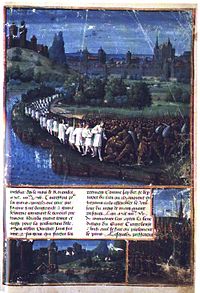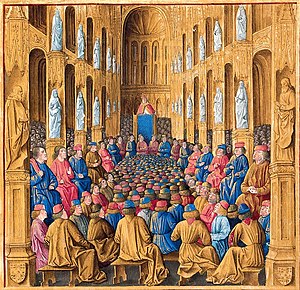Time to cover the Crusades. As some of you may know, there have been many crusades over the years, each with its own purpose and varying degree of success. What I’ve tried to do with this post is cover some of the most important and interesting Crusades in history. Some where fought by great Kings, while others had far more devious origins. Below are 6 Crusades I believe everyone should know at least something about. Enjoy.

6. People’s Crusade
This Crusade is a pretty interesting one. It is technically part od the first crusade, but only lasted from April to October of 1096. Before the true crusade could launch, a mass of untrained and largely unarmed peasants and minor-knights set out for Jerusalem. They were led by a skilled orator and holy man known as Peter the Hermit, as well as by a couple of trained, but low ranking knights; Walter Sans-Avoir and Fulcher of Chartes. On their way to Jerusalem, the army infamously stopped in many European towns and slaughtered the Jewish populations. The crusade was not against the Jews obviously, but a mixture of frustration, blood lust and anti-Semitism fueled this mass of undisciplined men to do some very unsavory things. Between Constantinople and Jerusalem, the army split and all control was lost by Peter and his allies. They met their final demise at the Battle of Civetot where a Turkish ambush sent the untrained army retreating almost instantly. The survivors made it to a nearby castle and where eventually rescued by Byzantine ships. Not a great start for the European crusaders and a good example of how badly these things could go.
5. 1st Crusade
The actual first crusade was announced by Pope Urban II in 1095 and called for all Christian soldiers to march to Jerusalem and reclaim the Holy Land. He also promised that any man who died while on the crusade would go to heaven. This offer was apparently enticing because a large force was amassed and Jerusalem fell to the Christians in 1099. Like any good Christian army would, they allowed all the inhabitants to leave freely. Just kidding. They slaughtered every Muslim and Jew they could find and then set up the Crusader States of the Kingdom of Jerusalem. This foray into the Islamic controlled Levant would set off countless other crusades and help to create the atmosphere of distrust and anger that still exists between these two groups today.
4. 3rd Crusade
Lasting from 1189-1192, this crusade has some of the biggest historical names tied to it. The Christian forces were led by Philip the Second of France, Richard the I (the Lionhearted) of England and Frederick Barabossa the Holy roman Emperor. These men set off to try to reclaim the lands taken by Muslim military genius Saladin. The Europeans had a shaky start to say the least. Frederick Barabossa fell off his horse and drowned during a crossing, sending most of his troops home in sorrow. Things looked up for a bit after this. The Europeans took Jaffa and Acre, but lost Philip II of France in 1191. Richard remained to carry on the crusade and although he never lost a battle against Saladin, he did not manage to take Jerusalem. The two signed a treaty in 1192 which kept Jerusalem under Muslim control, but allowed unarmed Christian pilgrims entry and access to holy sites. This crusade was followed by almost 10 years of relative peace, but the temptation of a Christian Jerusalem proved too much for the crusaders who tried to take it again in 1202.
3. 7th Crusade
This crusade took place from 1248-1254 and saw Louis IX of France try to retake Jerusalem after a Mongol advance had captured the city and returned it to the Muslims. The whole thing was a debacle. The army took the city of Damietta, but became trapped there by the flooding of the Nile. They were joined by Templars who bolstered their numbers, but could not stop the Egyptians from defeating them time and again. By 1250, Louis was jumping between cities trying to avoid capture, but was finally caught by the Egyptians. There is a story that during this time he grew ill and was healed by a Muslim physician. Many see this as an act of great Muslim generosity, but when you consider they ransomed him for 800,000 bezants (pieces of gold) it was probably just a solid business move.
2. Children’s Crusade
This is easily the saddest of all the crusades. If grown men want to hack each other to pieces over religious differences that’s fine, but this crusade was not really a crusade at all, but a slave making scam. This event supposedly took place in 1212 (many historians doubt the historical accounts) and saw a group of children rallied up to go on a crusade. They were largely poor and disenfranchised and stories vary as to whether they were tricked or led by a crazy person. Whichever it may have been, the story goes that these 30,000 children walked to the Mediterranean from Germany and France and met merchants willing to sail them to Jerusalem. Once on the boats, the children were not taken to the Holy Land, but to Tunisia to be sold as slaves. This is one of those history stories that you hope was at least exaggerated and hopefully a total fabrication. Unfortunately, I think that there is at least a sliver of truth here and a sliver is enough to make your skin crawl.
1. The Reconquista
Probably the most succesful European crusade, the Reconquista is the name given to the reconquest of Spain from the Moors. While it tends to be left out of many crusades lists, it was one of the first major European holy wars and was arguably the most successful. The Islamic invaders came in 711 AD and held control up until the fall of Granada in 1492. This period, which lasted almost 700 years, saw relations between Jews, Muslims and Christians in the area deteriorate greatly. In fact, once Spain wrested control from the Moors, they forced the Muslims and Jews of Spain to convert or be banished. This is a little ridiculous considering the Muslims allowed freedom of religion the entire time they were in power. If you go to Spain today you will see many churches and that used to be mosques and vice-versa. This is one of the most interesting parts of both Muslim and Spanish history and is well worth further reading.
Thanks for reading. For more history lists check out 8 Bloodthirsty Vikings You Should Know, 5 Famous Last Stands, Countdown! History’s 8 Largest Empires and 9 Historical Native American Figures.






